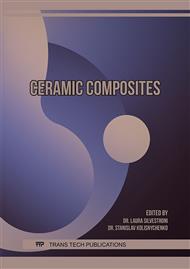[1]
W.G. Fahrenholtz, et al, Refractory diborides of zirconium and hafnium, J. Am. Ceram. Soc., 90 (2007) 1347-1364.
Google Scholar
[2]
S.Q. Guo, et al, Densification of ZrB2-based composites and their mechanical and physical properties: a review, J. Eur. Ceram. Soc., 29 (2009) 995-1011.
Google Scholar
[3]
J.K. Sonber, et al, Synthesis and consolidation of zirconium diboride:review, Adv. Appl. Ceram., 110 (2011) 321-334.
Google Scholar
[4]
W.W. Wu, et al, Microstructure and Anisotropic Properties of Textured ZrB2 and ZrB2-MoSi2 Ceramics Prepared by Strong Magnetic Field Alignment, Int. J. Appl. Ceram. Tech., 11 (2014) 218-227.
DOI: 10.1111/ijac.12061
Google Scholar
[5]
R.Z. Wang, et al, Effects of microstructures and flaw evolution on the fracture strength of ZrB2-MoSi2 composites under high temperatures, J. Alloys. Compd. 644 (2015) 582-588.
DOI: 10.1016/j.jallcom.2015.05.027
Google Scholar
[6]
X.T. Zhao, et al, ZrB2-SiCw ceramic composites synthesized by in-situ reaction and spark plasma sintering, Int. J. Appl. Ceram. Tech., 14 (2017) 845-850.
DOI: 10.1111/ijac.12720
Google Scholar
[7]
J. Watts, et al, Mechanical characterization of ZrB2-SiC composites with varying SiC particle sizes, J. Am. Ceram. Soc., 94 (2011) 4410-4418.
DOI: 10.1111/j.1551-2916.2011.04885.x
Google Scholar
[8]
D. Sciti, et al, Processing, sintering and oxidation behavior of SiC fibers reinfored ZrB2 composites, J. Eur. Ceram. Soc., 32 (2012) 1933-(1940).
DOI: 10.1016/j.jeurceramsoc.2011.10.032
Google Scholar
[9]
S.Q. Guo, et al, Mechanical behavior of two-step hot-pressed ZrB2-based composites with ZrSi2, J. Eur. Ceram. Soc., 29 (2009) 787-794.
DOI: 10.1016/j.jeurceramsoc.2008.06.037
Google Scholar
[10]
S. Gang, et al, ZrB2-ZrSi2-SiC composites prepared by reactive spark plasma sintering, Int. J. Refractory metals and hard mater., 60 (2016) 104-107.
DOI: 10.1016/j.ijrmhm.2016.07.011
Google Scholar
[11]
S.Q. Guo, Effects of sintering temperature and excess Zr on mechanical properties of reactive hot-pressed ZrB2-ZrCx-Zr Cermets, Key Eng. Mater., 697 (2016) 633-638.
DOI: 10.4028/www.scientific.net/kem.697.633
Google Scholar
[12]
D.W. Readey, Kinetics in materials science and engineering, Boca Raton, Florida, (2016).
Google Scholar
[13]
D.B. Miracle, et al, A critical review of high entropy alloys and related concepts, Acta Mater., 122 (2017) 448-511.
DOI: 10.1016/j.actamat.2016.08.081
Google Scholar
[14]
S. Otania, et al, Solid solution ranges of zirconium diboride with other refractory diborides: HfB2, TiB2, TaB2, NbB2, VB2 and CrB2, J. Alloys Compd., 475 (2009) 273-275.
DOI: 10.1016/j.jallcom.2008.08.023
Google Scholar
[15]
A.A. Miguel, et al, Mechanosynthesis of Hf1-xZrxB2 solid solution and Hf1-xZrxB2/SiC composite powders, J. Am. Ceram. Soc., 93 (2010) 696-702.
Google Scholar
[16]
D.L. Mclane, et al, Thermal properties of (Zr,TM)B2 solid solutions with TM=Hf, Nb, W, Ti, and Y, J. Eur. Ceram. Soc., 97 (2014) 1552-1558.
DOI: 10.1111/jace.12893
Google Scholar
[17]
L. Silvestroni, et al, TEM analysis, mechanical characterization and oxidation resistance of a highly refractory ZrB2 composite, J. Alloys Compd., 602 (2014) 346-355.
DOI: 10.1016/j.jallcom.2014.02.133
Google Scholar
[18]
D. Sciti, et al, Sintering and mechanical properties of ZrB2-TaSi2 and HfB2-TaSi2 ceramic composites, J. Am. Ceram. Soc., 91 (2008) 3285-3291.
DOI: 10.1111/j.1551-2916.2010.04317.x
Google Scholar
[19]
L. Silvestroni, et al, Transmission electron microscopy on Zr- and Hf- borides with MoSi2 addition: densification mechanisms, J. Mater. Res., 25 (2010) 828-834.
DOI: 10.1557/jmr.2010.0126
Google Scholar
[20]
H.L. Wang, et al, The processing and properties of (Zr,Hf)B2-SiC nanostructured composites, J. Eur. Ceram. Soc., 34 (2014) 4105- 4109.
DOI: 10.1016/j.jeurceramsoc.2014.05.020
Google Scholar
[21]
B. Basu, et al, Dynamic compression behavior of reactive spark plasma sintered ultrafine grained (Zr,Hf)B2-SiC composites, Ceram. Int., 41 (2015) 8468-8474.
DOI: 10.1016/j.ceramint.2015.03.052
Google Scholar
[22]
H.L. Wang, et al, Nano-Hafnium diboride powders synthesized using a spark plasma sintering apparatus, J. Am. Ceram. Soc., 95 (2012) 1493-1496.
DOI: 10.1111/j.1551-2916.2012.05141.x
Google Scholar



